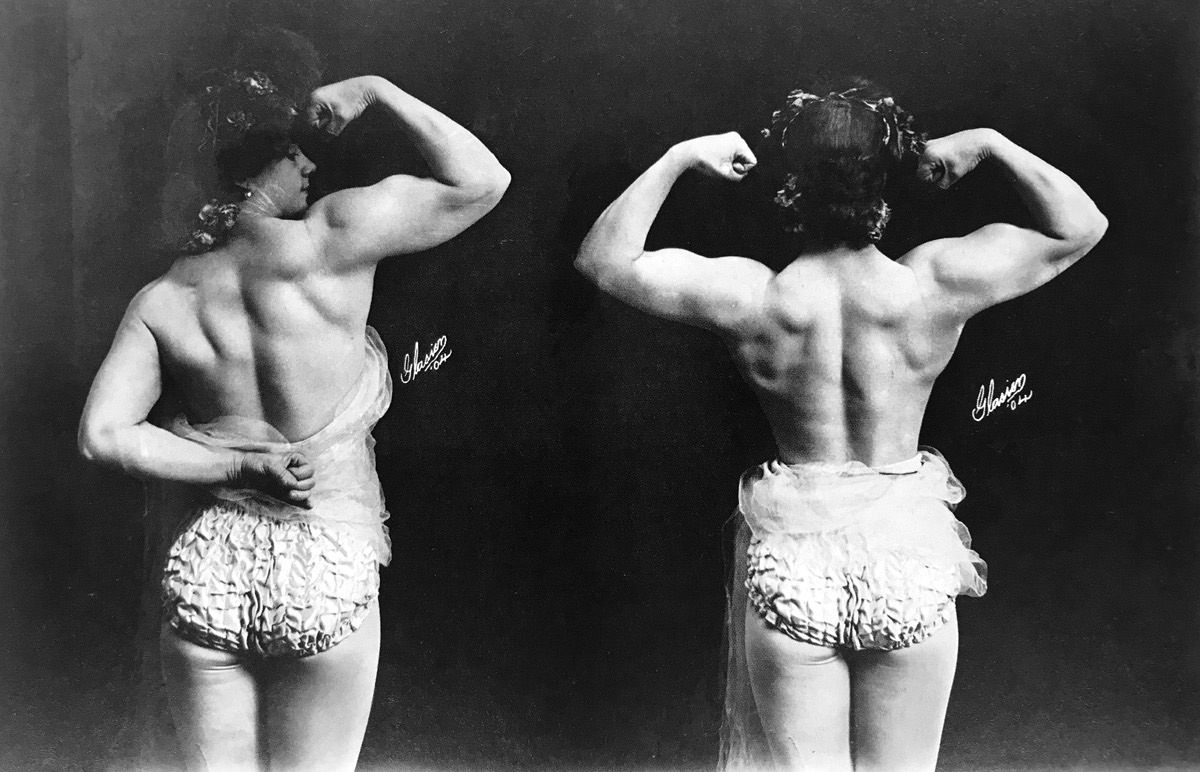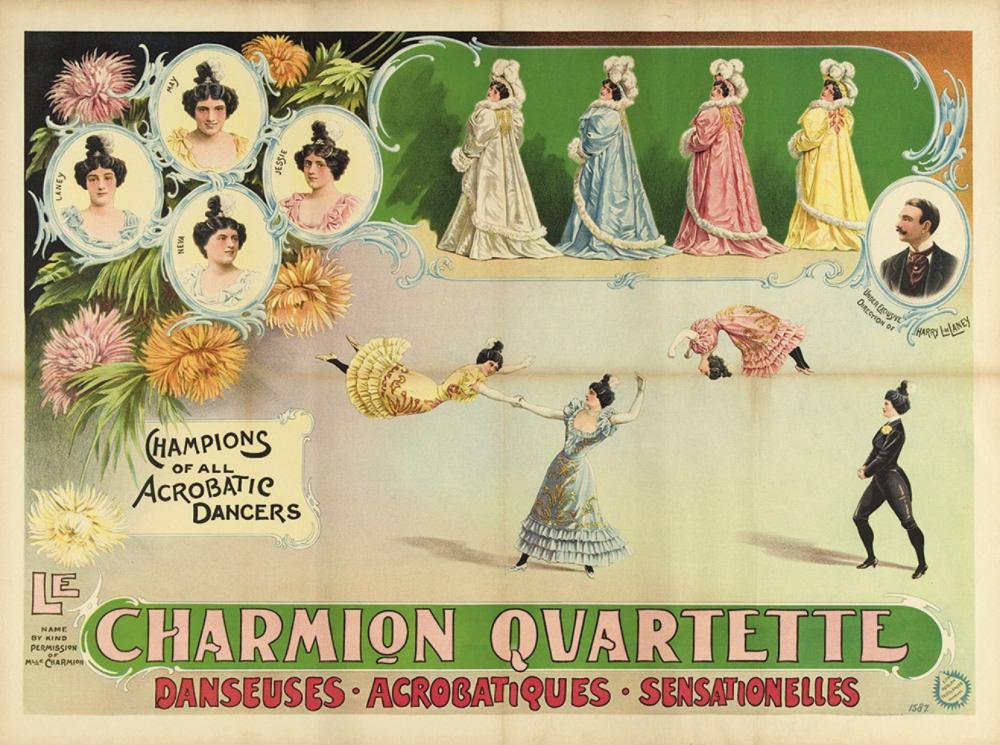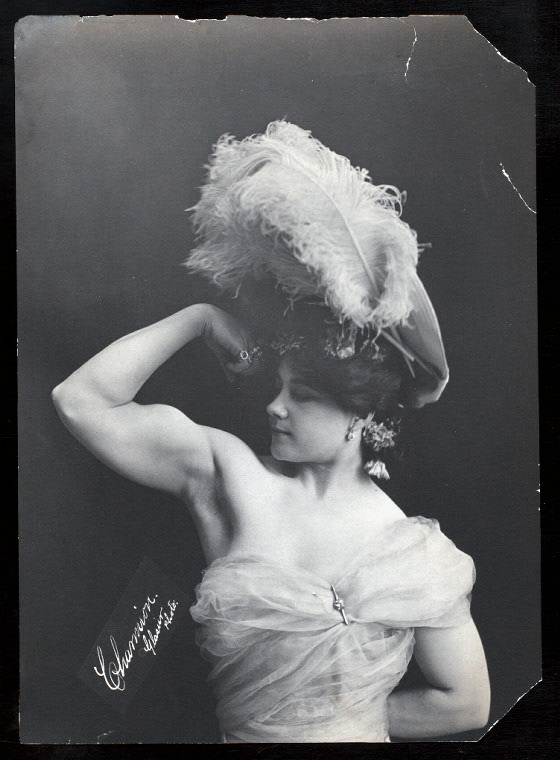
Born Laverie Cooper on 18 July 1875 in Sacramento, California, Charmion was billed as French, adding a certain exoticism to those faire des galipettes.

In the mid-1890s, she began to attract attention for her gymnastic work on the rings, and was performing in Sacramento and San Francisco under the stage name of Lavevi Charmion. She formed a local gymnastic troupe, but it wasn’t a hit, and looking for work she soon arrived at the New York Vaudeville Company. She toured with them throughout the United States and Europe. And had the idea of adding a striptease to her act.
George Nathan Jean and his father saw one performance:
“By way of prolonging the terrible suspense, our temptress now maddeningly drew forth a small lace handkerchief from her bodice and cast it aside. She thereupon added insult to injury by slowly adjusting a hairpin in her coiffure. But wait! One by one now off came the stockings, revealing a pink silk garter underneath.”
By the end, she was dressed in nothing but a leotard. Not naked, but alluring enough to thrill the crowd and have them baying for more. A reporter in Washington D.C. for the Evening Times called her show “revoltingly disgusting, coarse and disagreeable”. You can’t buy that sort of publicity.

A performance of 25th of December 1897 at Koster and Bial’s theatre in New York was described by a reporter for the New York Dramatic Mirror thus;
“A few steps brought her to the rope by which she was hoisted on the trapeze. She then attempted one or two tricks, but seemed to find her clothes a bother, so she began to unhook her waist. When she began to take it off she exhibited all the shyness of a timid girl. Finally the waist came off.”

In 1898, the compere at a show in Paris was duty bound to tell the crowd that the female acrobat could not perform. The crowd groaned. But one spectator stood up. She could do it. It was Charmion, of course, and on her trapeze she addressed the audience, telling them about the human body – fitness, beauty and health. She was on-trend. This was the age of Doctor Gustaf Zander’s steam-powered exercise machines, those fabulous Ziegfeld Girls, cycling (and cycling for women), Swedish gymnastics and the rising interest in eugenics. and female suffrage.

On the 3rd of August 1898, Charmion would perform at the Alhambra in London. The Morning Post was there:
“The twilight of impropriety passed, the performance deserves nothing but praise. Charmion is so clever an artist that she can introduce on the trapeze contortions which few can exhibit on the floor, and yet do all so gracefully that she not merely attracts but fascinates and charms.”
Possessed of a sense of theatricality, charisma and business acumen, Charmion sold merchandise featuring her own images, such as pins and pictures. Before long she’d become the highest-earning female performer vaudeville on American stages, receiving over $200 a week.
Inventor Thomas Edison’s Edison Studios capitalised on her popularity with a film appearance. In 1894, Edison had filmed the strongman Eugen Sandow. And in 1901, Edison released the Trapeze Disrobing Act, starring Charmion, the “female Sandow”.
https://youtu.be/dFf9WQNYS9Y
“The scene is on the stage of a vaudeville theatre. A lady dressed in evening costume is performing on a trapeze. Two Rubes are seated in a box in the theatre. The lady begins to disrobe and here the fun commences. As she removes her garments one by one and throws them at our rural friends, they begin going through antics, which to say the least, are highly amusing. When the stockings come off, the climax takes place. The Rubes jump from their seats and make things lively for a short time in the theatre.”
Harry Delaney — Charmion’s husband, manager, and trainer — died away in 1905. She remarried in 1912, to wrestler William Vallee. She moved back to California later in life, and died in 1949 in Santa Anna, Orange County.
Lead image: Charmion by Frederick Whitman Glasier in 1904.
Would you like to support Flashbak?
Please consider making a donation to our site. We don't want to rely on ads to bring you the best of visual culture. You can also support us by signing up to our Mailing List. And you can also follow us on Facebook, Instagram and Twitter. For great art and culture delivered to your door, visit our shop.



